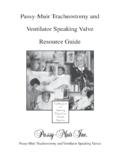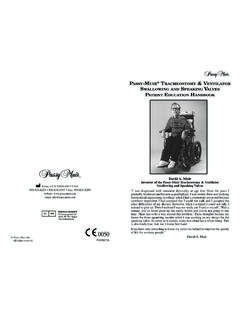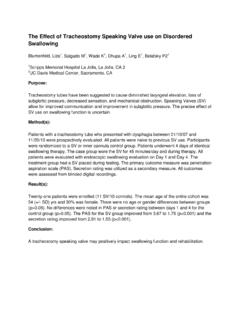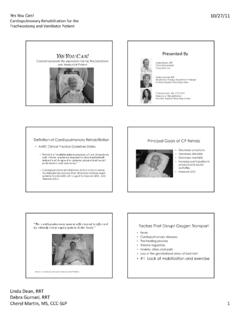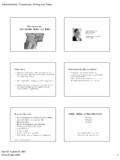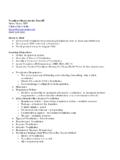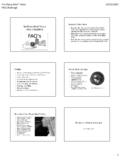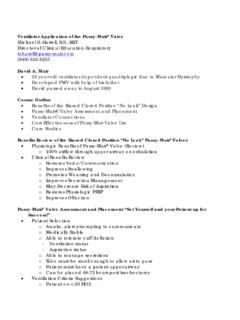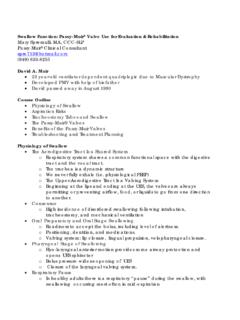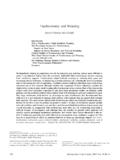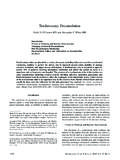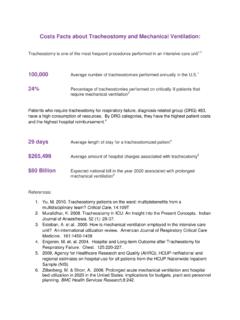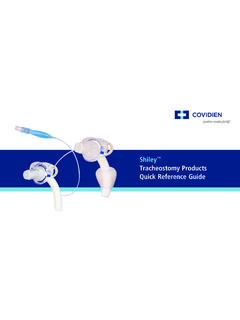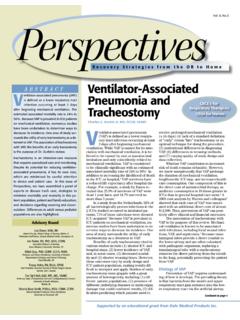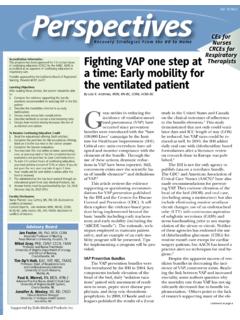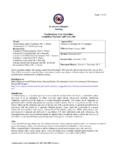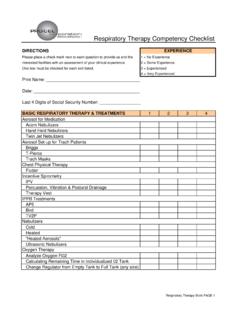Transcription of Interdisciplinary Decision-Making with Patients …
1 Interdisciplinary Decision-Making with Patients Requiring tracheostomy and Mechanical Ventilation Interdisciplinary Decision-Making with Patients Requiring tracheostomy and Mechanical Ventilation Carrie Windhorst MS CCC-SLP. Cheryl Wagoner MS CCC-SLP. Ricque Harth MEd CCC-SLP. Where do we come from? Welcome to Madonna Rehabilitation Hospital Lincoln, Nebraska Passy-Muir Inc. 1. Interdisciplinary Decision-Making with Patients Requiring tracheostomy and Mechanical Ventilation Madonna Rehabilitation Hospital is a Catholic organization that exists to provide medical and rehabilitation services to children and adults with physical disabilities throughout the nation and to create and share improved methods to reduce disability through research in rehabilitation science and engineering. Madonna Rehabilitation Hospital Seeks to Rehabilitate those who have sustained injuries or disabling conditions to the highest level of independence possible.
2 Lead research to improve rehabilitation outcomes and prevent physical disabilities through community programs. Madonna Rehabilitation Hospital Business Lines Hospital Outpatient ProActive Long Term Care Passy-Muir Inc. 2. Interdisciplinary Decision-Making with Patients Requiring tracheostomy and Mechanical Ventilation Madonna Rehabilitation Hospital 96 Long Term Acute Care Hospital (LTACH) beds 72 Acute Rehabilitation Unit (ARU) beds 25 Subacute Rehabilitation (SAR) beds 14 Adolescent & Child Rehabilitation beds Admissions from across the country States that have admitted Patients to Madonna (23 total). Brain Injury Approximately 200. inpatients and 225. outpatients per year Very severe to mild Mild TBI. Comprehensive Assessment &. concussion Study Follow-up CARF Accreditation Passy-Muir Inc. 3. Interdisciplinary Decision-Making with Patients Requiring tracheostomy and Mechanical Ventilation Spinal Cord Injury Approximately 100.
3 Inpatients and 50. outpatients per year All levels of injury F ll Follow-up CARF Accreditation Stroke Approximately 300. inpatients and 225. outpatients per year Severe to very mild Follow-up F ll First in Nebraska to be CARF Accredited Adolescent & Child Rehabilitation Program Birth through 18 years old Approximately 50 inpatients and new 175 outpatients per year Tech Tots Therapeutic Learning Center CARF Accreditation . Pediatric Family Centered Passy-Muir Inc. 4. Interdisciplinary Decision-Making with Patients Requiring tracheostomy and Mechanical Ventilation How did we get here? ASHA Leader publication, January, 2009. Received several follow-up emails, contacts C. Comments, t questions ti about b t policies, li i protocol t l development Passy-Muir . Presented at our state convention and ASHA. Course Objectives Demo understanding of anatomy and physiology for speech and swallow D ib th Describe l ti and the evaluation d ttreatment t t planning options for Patients who require a tracheostomy tube and mechanical ventilation Objectives Cont.
4 Identify the five major steps involved in the Passy-Muir closed position one-way speaking valve assessment Describe the clinical benefits of the Passy Passy- Muir closed position one-way speaking valve Passy-Muir Inc. 5. Interdisciplinary Decision-Making with Patients Requiring tracheostomy and Mechanical Ventilation Basic Anatomy Review tracheostomy Basics tracheostomy Function: Long term airway management (>7 days). Used with or without ventilator Without ventilator ventilator, tracheostomy used to deliver humidified oxygen or room air Case Study 33 male Admitted to MRH 7/20/09. RLA level 3, opens eyes with Dx TBI 2' to MVA, stim, some visual tracking, resp failure, multiple inconsistent commands fx's No speaking valve trialed up to this point Hx DM on insulin Speech addressing oral stim . Onset 7/2/09 no PO trials 7/28/09 initial one-way PEG 7/10/09, Trach speaking valve assessment 7/9/09 completed, trials of ice, puree Passy-Muir Inc.
5 6. Interdisciplinary Decision-Making with Patients Requiring tracheostomy and Mechanical Ventilation Ventilator Basics Mechanical Ventilation is used to treat hypoxemia, deliver positive airway pressure to decrease the work of breathing b eat g a anddp provide o de ventilation e t at o for o Patients who can't effectively ventilate themselves. Two most common ventilators used at our facility Achieva Ventilator Espirit Ventilator Passy-Muir Inc. 7. Interdisciplinary Decision-Making with Patients Requiring tracheostomy and Mechanical Ventilation Case Study 88 female Admitted to MRH 7/29/09. Dx Bowel resection, Alert, decreased comprehension for multi-step respiratory failure commands, limited Ischemic small bowel communication intent, responds inconsistently to y/n Onset 7/8/09 with ith h head d nods d PEG 7/28/09, Trach No speaking valve trialed up to 7/22/09 this point Speech therapy had not evaluated 7/29/09 initial one-way speaking valve assessment completed, trials of ice, puree, liquids min silent aspiration Background with the increased medical technology there has been a steady increase in the number of Patients admitting to our 168.
6 Bed rehabilitation hospital with tracheostomy tube and mechanical ventilation. Passy-Muir Inc. 8. Interdisciplinary Decision-Making with Patients Requiring tracheostomy and Mechanical Ventilation Patients Admitted to MRH. on Ventilator 2001 17. 2002 62. 2003 86. 2004 131. 2005 137. 2006 124. 2007 116. 2008 112. 2009 117. Patients Admitted to MRH. with tracheostomy Tube 2001 33. 2002 108. 2003 158. 2004 186. 2005 180. 2006 201. 2007 188. 2008 177. 2009 205. Protocol Development Developed with a team approach involving the pulmonary medical director, respiratory therapy and communication disorders departments To establish a standardized method for the evaluation and safe weaning of tracheostomy tube support. Provides step-by-step process for each discipline to follow Passy-Muir Inc. 9. Interdisciplinary Decision-Making with Patients Requiring tracheostomy and Mechanical Ventilation Co-Evaluation and Treatment Initial Evaluation following physician order: Speech Therapy and Respiratory Therapy to co-evaluate co evaluate and trial speech devices within 48 hours.
7 Contra-indications Contra-indications for use of a Passy-Muir closed position one-way speaking valve Severe medical instability Severe airway obstruction Severe aspiration risk is a consideration Use of foam filled trach tube cuffs RT and SLP Evaluations RT Evaluation SLP Evaluation Trach Tube Type Speech Status of Cuff Voice Stoma Pressure Language Cuff Pressure and Volume Cognition Vital Signs Swallowing Vital Signs Passy-Muir Inc. 10. Interdisciplinary Decision-Making with Patients Requiring tracheostomy and Mechanical Ventilation Initial Evaluation Goals Identify a mode of communication Assess patient's risk for aspiration Assess patient's tolerance for trach cuff deflation Trial one-way valve if indicated Assess trach tube size/type for valve AND EDUCATION!!! Both disciplines are responsible for providing education to patient's patient s and families as the patient works through adjusting to the use of the Passy- Muir speaking valve Stop Criteria HR > 20 BMP.
8 RR > 35. SpO2 < 90%. FiO2 60%. RPD > 6. Passy-Muir Inc. 11. Interdisciplinary Decision-Making with Patients Requiring tracheostomy and Mechanical Ventilation HR and RR determined based on general cardiac guidelines MRH uses guideline of SpO2 >90. FiO2 off 50 or > concerns ffor O2 ttoxicity i it RPD Rate of Perceived Dyspnea Measure of shortness of breath Rating of 6 moderate SOB. Rate Perceived Dyspnea Scale 0 None 1. 2 Just noticeable 3. 4 Mild 5. 6 Moderate 7. 8 Severe 9. 10 Unbearable tracheostomy Tube Weaning Pathway I. tracheostomy tube cuff deflation (performed by LRCP). Stop Criteria Present: YES: LRCP will re re-inflate inflate trach cuff cuff. LRCP and SLP will reassess patient and/or consult physician before progressing NO: Advance to One-Way Valve Trial. Passy-Muir Inc. 12. Interdisciplinary Decision-Making with Patients Requiring tracheostomy and Mechanical Ventilation Expect significant secretions to be present Be prepared for additional tracheal and/or oral suctioning Remember R b the th ddefinition fi iti off aspiration i ti The passage of food or liquid through the vocal folds.
9 Goal: decrease aspiration risk by helping the patient to improve secretion management. How: using Passy Muir closed position Passy-Muir one-way speaking valve tracheostomy Tube Weaning Pathway II. One-way valve trial Stop Criteria Present: YES: LRCP Will remove valve. LRCP and SLP. will consult with physician for possible downsizing of tracheostomy tube NO: Advance to One-Way Valve as tolerates Passy-Muir Inc. 13. Interdisciplinary Decision-Making with Patients Requiring tracheostomy and Mechanical Ventilation Goal: SLP evaluate swallow, speech, voice How: assessing patient's sensation of secretions with demonstration of reflexive cough/throat clear, reflexive swallow and patient's ability to phonate and produce speech Why: appropriate treatment recommendations or referrals cannot be made until the Passy- Muir speaking valve assessment has been completed. tracheostomy Tube Weaning Pathway III.
10 One-way Valve as tolerates (patient increases use of closed position one-way speaking valve throughout day and evening hours). Stop Criteria Present: YES: Reassess patient to determine barriers NO: Advance to tracheostomy Tube Capping for appropriate Patients Treatment Voice exercises Speech/Ventilator timing Therapeutic PO trials Dysphagia swallowing exercises Passy-Muir Inc. 14. Interdisciplinary Decision-Making with Patients Requiring tracheostomy and Mechanical Ventilation tracheostomy Tube Weaning Pathway IV. tracheostomy tube capping trials Appropriate Patients include: non-ventilator dependent Patients and Patients on nocturnal ventilation and/or PRN mechanical ventilation that have met all previously noted criteria criteria. Repeat steps III and IV using tracheostomy tube cap. Stop Criteria Present: YES: Consider additional trach tube downsizing. NO: Once patient can tolerate trach cap without interruption for a minimum of 48 hours, LRCP may request physician order to decannulate.
